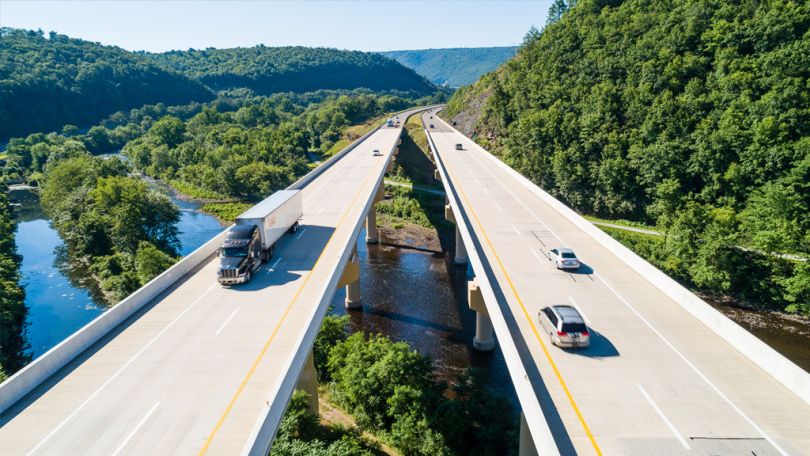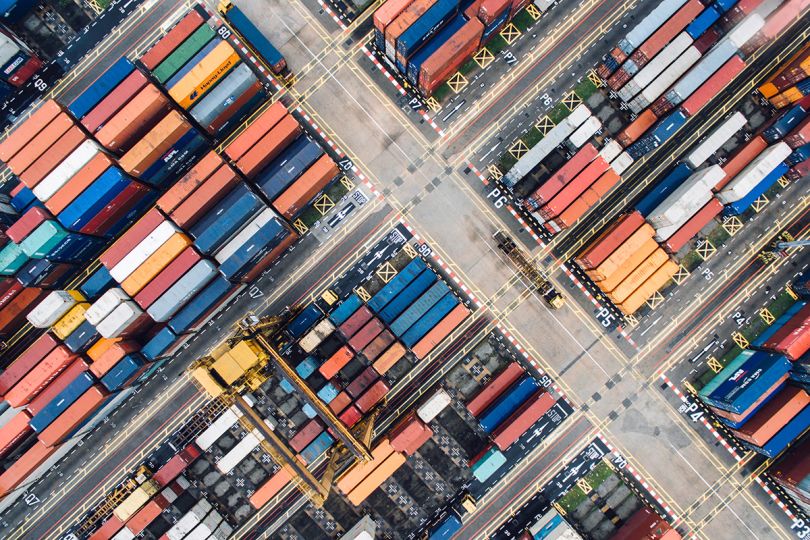When asked to simplify the $800-billion freight transportation market, DAT’s Chief Scientist Chris Caplice puts it simply: “At the end of the day, everything moves on a truck.”
While stalled boats packed with shipping containers may have dominated headlines over the last year due to supply chain issues, those shipments still have a long way to go to reach their final destination of warehouses, stores, and eventually, your front door.
“These shipments get broken down into smaller and smaller pieces,” Chief of Analytics Ken Adamo said. “Eventually, it all rolls down to trucking.”
This is where the logistics start to get a bit more complex.
“Just before DAT was founded, the freight industry was deregulated,” Caplice said. “Before the 1980s, it was a highly regulated space run by a small number of monopolies that operated in certain geographies. When it was deregulated, suddenly there were millions of shippers trying to buy transportation, hundreds of thousands of available carriers, and all of these brokers in the middle trying to orchestrate it all.”

Shippers, carriers, brokers. What’s the connection?
According to Caplice, one of the main challenges in the industry has always been for shippers and brokers to find carriers who have the capacity to carry the right amount of cargo at the right time for the right price. This is the issue DAT was built to solve in 1978, by providing a freight marketplace that connects all three parties, creating more efficient transportation options. Ultimately, that means more goods moving faster.
Fast forward to 2022. The Covid-19 pandemic and a mighty e-commerce boom have spurred new advancements in the industry, ushering in an era of increased public interest and burgeoning digitization. To Chief of Analytics Ken Adamo, this acceleration of new technology and increased awareness of the supply chain makes now an especially exciting time to join the field.
“It’s a great time to be in the industry because the toothpaste isn’t going back in the tube,” Adamo said. “DAT inspired this digital frontier 44 years ago, and it’s why we’re on the front lines of this digital boom in the supply chain industry today. I’m really excited to be a part of it.”
To learn more about where the North American supply chain has been, and where it’s heading, Built In connected with Adamo, Caplice, and Director of Product Management Sarita Benjamin. The trio of industry veterans filled us in on the impact of DAT’s work, how it affects people across the United States, and why, in the world of logistics, all roads lead to trucks.
Can you tell us a bit more about how DAT’s platform works?
Director of Product Management Sarita Benjamin: We enable shippers and brokers to find the right carrier for their needs, and ensure they trust those carriers. We provide all of the tools for our brokers, carriers, and shippers to move freight using our digital marketplace, and to ensure they never have to “drive empty.” We want all three parties to be able to build relationships with one another, find the right match, expand their networks, and do business on our platform.
Another aspect of what we do is provide access to brokers. If a shipper or carrier hasn’t worked with a specific broker, we give them tools to onboard with these brokers, and in turn, enable brokers to grow their networks. Brokers look at increasing capacity to ensure they have access to as many carriers as possible so that they always have loads moving. They come to our platform to build those relationships and expand their networks.
Chief Scientist Chris Caplice: We also help customers understand what is going on in the market, and help them see if they’re doing something wrong, like quoting prices above the market rate. We also work in predictive information, where we predict what rates will be going forward.
That rate-casting is really helpful because it helps shippers, carriers, and brokers understand what the market rate will do, which allows them to plan for the future. Finally, there’s a prescriptive side to data science, which helps people understand how they can improve relationships with other parties.
Chief of Analytics Ken Adamo: Let’s say someone created an app that was far better than Uber, in terms of how intuitive it was and how much cheaper the prices were. Why wouldn’t someone use it? Because Uber has millions of cars at their disposal, and this new app might only have hundreds or thousands.
When people use DAT, they’re assured they’re going to find that kind of high capacity. For us, those are table stakes because you won’t get far in this business without density, and you certainly can’t scale. On top of that density, we add high quality, an ease of use, and the type of creature comforts that make our product sticky and easy to come back to.

We’ve heard a lot about the supply chain issues brought on by the pandemic. How does this impact the freight industry?
Caplice: All of the problems that were exacerbated by the pandemic have always been there. It all just suddenly became more apparent. Finding capacity has always been an issue in the industry, but it just got worse over the last two years since so much change was being introduced.
Before this age of uncertainty, shippers would typically come up with a shipping plan about once a year, thinking they could map everything out. That hasn’t been possible during the pandemic. Now, there’s more of a need to execute shipping dynamically and intelligently. The expertise has moved from creating plans to becoming more adept at execution. Now, there are more brokers, there’s an increasingly dynamic market, and shippers, carriers, and brokers are becoming more responsive and need more information. That’s where we come in, as we’re able to provide them with the information they need to make better decisions in real time.
Adamo: A lot of shifts in the industry started with the e-commerce boom, and Covid-19 has really just poured gasoline on that fire. When the pandemic hit, we saw more of a shift from traditional brick-and-mortar to e-commerce and direct-to-consumer products. Now, transportation networks like density: whether it’s freight or airlines, shippers want ways to consolidate their shipping, and they also want to branch out. That’s really difficult to do, especially with the rise in e-commerce. When businesses get deliveries, it’s usually hundreds or thousands of packages. If you’re without data in that situation, you’d be pretty lost.
We really saw the pandemic accelerate a digital revolution in the industry. For example, there used to be a system that involved “trip packs,” which is a stack of paperwork you’d finish after you made your delivery as a truck driver. But what happens to that system when you can’t get out of your truck cab due to Covid-19? It’s hard to believe, but the trucking industry was that far behind. It only deregulated two years after the airline industry, so this is the equivalent of all of us still using paper boarding passes on planes.
peek into the rise of digital solutions in freight logistics
DAT has a tremendous amount of data. What’s the impact of all of that information?
Adamo: We partner with more than 1,200 companies that essentially give us a bunch of data. We anonymize, aggregate, and analyze it, then feed it back to our customers in a way that adds a lot more value than they could ever derive from using their own data or research individually. What our shippers want to know is what the market will bear, and that they’re not overpaying. Many frontline brokers are operating in very entry-level positions. We provide them with the data and insights they need to get better at their jobs, get up to speed quickly, and have a competitive advantage.
A couple of years ago, we launched our first predictive tool which forecasted how much it would cost to move a shipment in a certain location. Let’s say a particular shipment weighing 35,000 pounds has a two-day lead time. Instead of just listing a bunch of carriers, we provide carriers based on a shipper’s activity that might be a good match. So, we’re moving up from descriptive analytics to predictive analytics, and adding a lot of insight.

What are some new tools DAT is working on?
Benjamin: Currently, we’re working on integrating the shipper, broker, and carrier experiences to make them more seamless and holistic. Our No.1 priority is the booking experience. We want to enable brokers to book loads 24/7, not just during business hours. We’re also looking into eliminating the need for shippers or brokers to pick up the phone and negotiate a rate for one specific load, which can take up to 30 phone calls. We are figuring out how we can give them access to a network with more tech-savvy carriers, by analyzing the typical carriers or brokers they work with, and giving them the ability to match with them.
Another goal is to provide our carriers with the most up-to-date loads that are available to them, so they never have to drive empty. As soon as they finish a specific leg, they come to our freight-matching solution to see the next load they can get. DAT’s aim is to eventually start pushing loads to them, based on their historical behavior. That way, they always trust that we can take them to their next location, and they don’t have an empty truck. From a standpoint of integrating cost data, we’re trying to ensure we give both brokers and carriers the rates they need to have the information to negotiate and book their load at the price that’s suited for them.
The road to increased sustainability
In a quickly growing industry, what makes DAT stand out from the competition?
Adamo: DAT has been around for 44 years, so what really sets us apart is our expertise in the industry. We have folks on our product team who have been doing this work for three decades. We also have relationships with all of the top firms in the industry, whether you’re a shipper, broker, or carrier. We have a working relationship with every truck you see going down the highway with a recognizable name, along with 99 out of 100 of the top brokers.
When you combine our people, our relationships, and the absolute most data in the industry, that’s what differentiates us.







